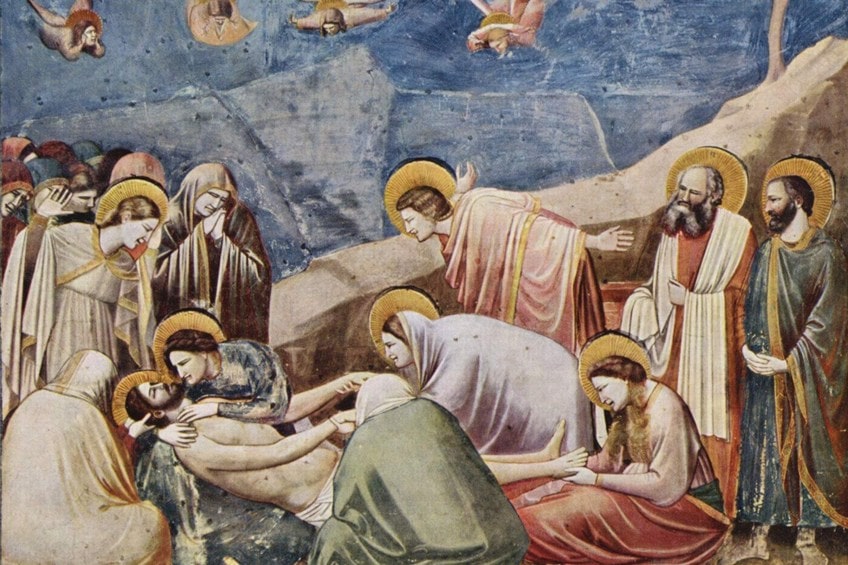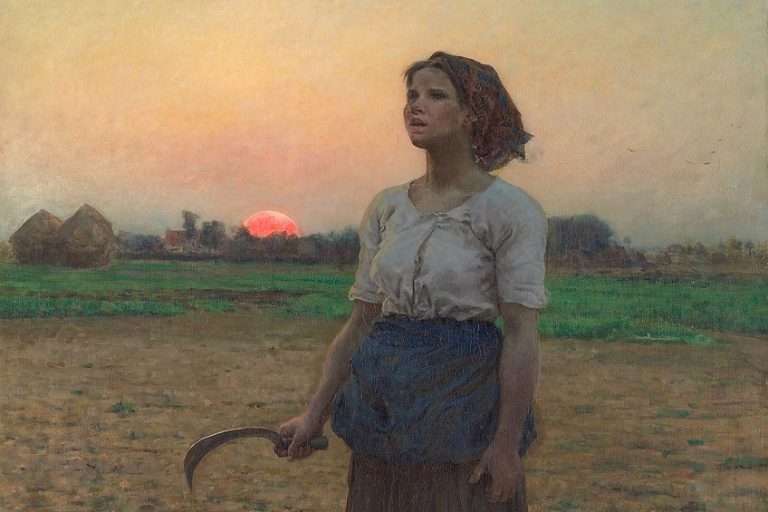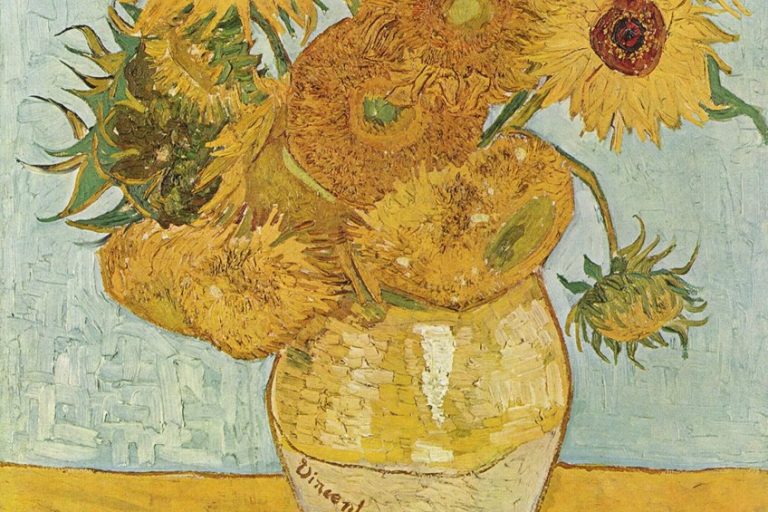“The Lamentation of Christ” by Giotto di Bondone – An Analysis
The lamentation of Christ is a popular theme throughout art history, depicting the moment of mourning over Christ’s dead body. This article will explore the famous depiction by the Proto-Renaissance artist Giotto di Bondone.
Artist Abstract: Who Was Giotto di Bondone?
Giotto di Bondone was a Florentine artist from the late Gothic and Proto-Renaissance period. He was believed to be born around 1267 and died in 1337. He was known for his artistic talent from a young age and was believed to be the apprentice to the well-known Italian artist Cimabue.
A widely believed story is that Cimabue found one of Giotto’s drawings of one of his sheep on a slab/piece of stone.
Giotto traveled throughout Italy and was commissioned by numerous significant figures, among them the King of Naples who was Robert of Anjou. Giotto’s artistic style introduced new ways of portraying the human with more three-dimensionality compared to the flatter representations seen in medieval Byzantine art that came before him.
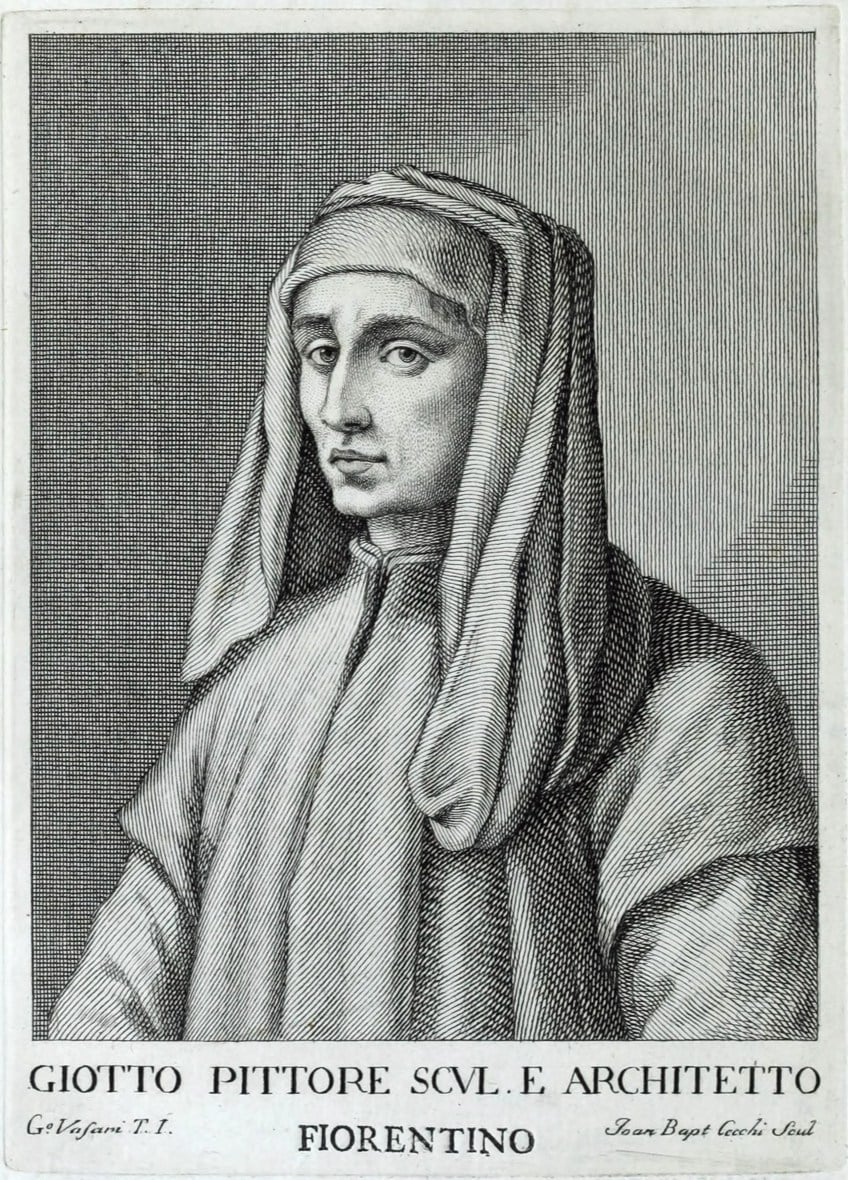
The Lamentation of Christ (c. 1304 – 1306) by Giotto di Bondone in Context
In the Giotto Lamentation analysis below, we will start with a brief socio-historical overview, discussing the Proto-Renaissance art period in more detail as well as how the painting is part of a larger project that was for the Arena Chapel in Padua.
This will be followed by a formal analysis, discussing the subject matter of The Lamentation painting as well as in terms of art elements like color, texture, line, shape, form, and space to shine the spotlight on Giotto’s artistic style.
| Artist | Giotto di Bondone |
| Date Painted | c. 1304 – 1306 |
| Medium | Fresco |
| Genre | Religious painting |
| Period / Movement | Proto-Renaissance |
| Dimensions (cm) | 200 x 200 (approximately) |
| Series / Versions | Part of a cycle of narrative frescoes about the Life of Christ |
| Where Is It Housed? | Arena (Scrovegni) Chapel, Padua, Italy |
| What It Is Worth | N/A |
Contextual Analysis: A Brief Socio-Historical Overview
When Giotto painted The Lamentation, it was during the 14th century, a period in history marked as the proto-Renaissance (the word “proto” is defined as “earliest” or “first”), which is dated to around 1300 to 1400. It was a style of art that originated before the Renaissance. Before Giotto pioneered his new techniques of depiction, which were characterized by subject matter that appeared more naturalistic, Byzantine art was mostly dominant, originating from the Roman Empire from around 330 CE.
Byzantine art was characterized by two-dimensional, often referred to as “flat” and “stylized”, figures and centered mostly around Christian subject matter, rendered as iconography, wall paintings, and mosaics. Gold was extensively utilized in paintings and mosaics, often as golden backgrounds. This was a distinguishing factor of Byzantine art.
Italian, notably Florentine, artists painted in what is termed the Italo-Byzantine art style, which originated from Byzantine art.
However, artists like Cimabue, who was Giotto’s mentor, pioneered new methods of representation that verged on three-dimensions and pictorial depth compared to two-dimensional and decorative Byzantine art. Although Giotto was Cimabue’s apprentice, he was considered as overtaking his mentor, but nonetheless, Cimabue was an important bridge between the old, medieval, and new methods of art, and another artist to be aware of when studying the Renaissance.
Giotto and the Arena Chapel
The Arena Chapel, also named the Scrovegni Chapel, was built on a site that was previously a Roman arena. The land was bought by Enrico Scrovegni in 1300, who built his palace on the site too. He commissioned Giotto around 1303/1304 to paint and decorate the interior walls of the chapel, a project that lasted until 1305/1306.
There are 38 frescoes decorating the interior walls, and depicting the stories as follows: The Life of Mary, The Life of Christ, The Last Judgment, Vices and Virtues, as well as the Starry Sky that depicts various Biblical figures in medallions, otherwise described as “roundels”.
It is believed that Enrico Scrovegni wanted to build the chapel as a form of atonement for the sin of usury, which is the act of lending money with high interests, often to a degree that is unreasonably high. Interestingly, he is depicted as the kneeling figure offering the chapel to the three figures, one of whom is the Virgin Mary, in one of the frescoes titled The Last Judgment (c. 1305).
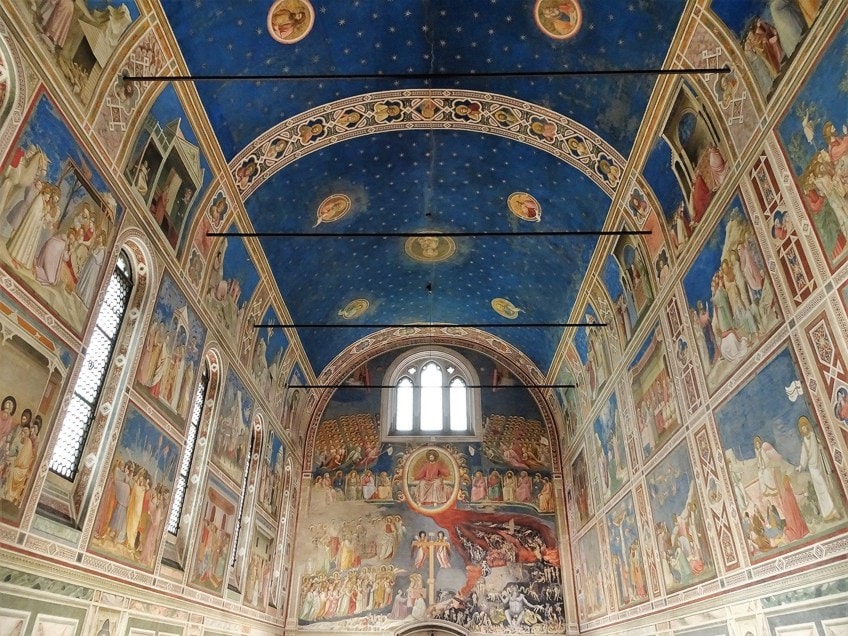
Formal Analysis: A Brief Compositional Overview
Below, we will take a closer look at the fresco titled The Lamentation of Christ by Giotto di Bondone, which is located on the left wall of the Arena Chapel in Padua, Italy, and is part of a series of frescoes that decorate the interior of the chapel.
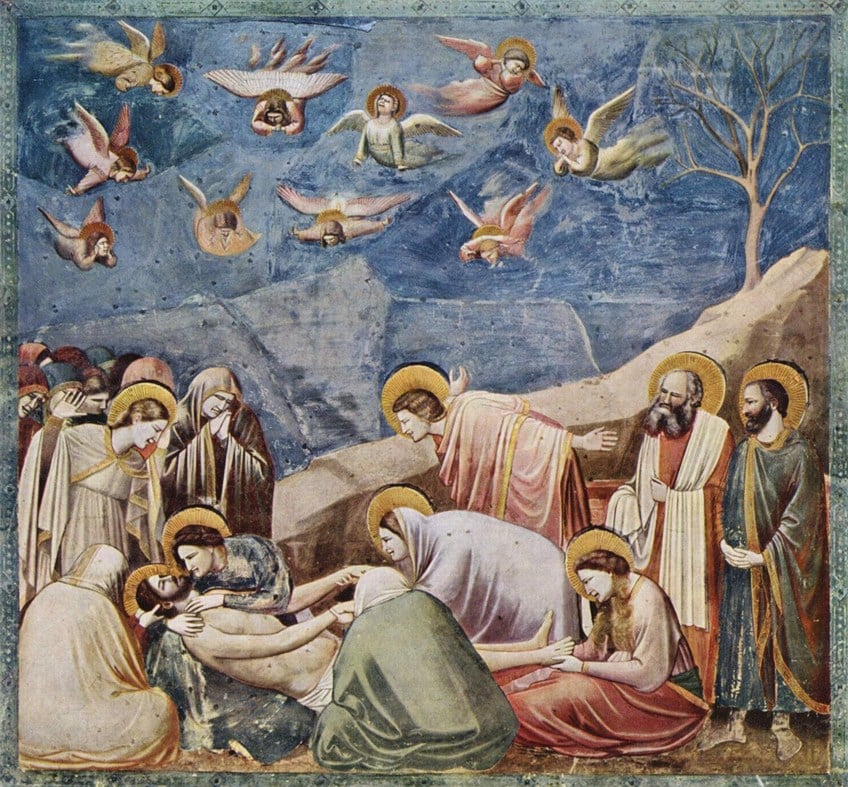
Visual Description: Subject Matter
In Giotto’s Lamentation painting, there are several figures arranged around the figure of Jesus Christ, who is lying lifeless on the ground after He was removed from the cross. His body does not appear to be completely on the ground; Mother Mary is holding His head and upper torso in her arms while Mary Magdalene is holding His feet.
There is a woman standing, partially hunched over Jesus’s body, holding His left wrist while slightly lifting His arm while another figure, with her (or his) back to us, the viewers, holds His right wrist, also slightly lifting His arm.
There is another figure sitting with their back to us in the bottom left corner, cradling the back of Jesus’ head.
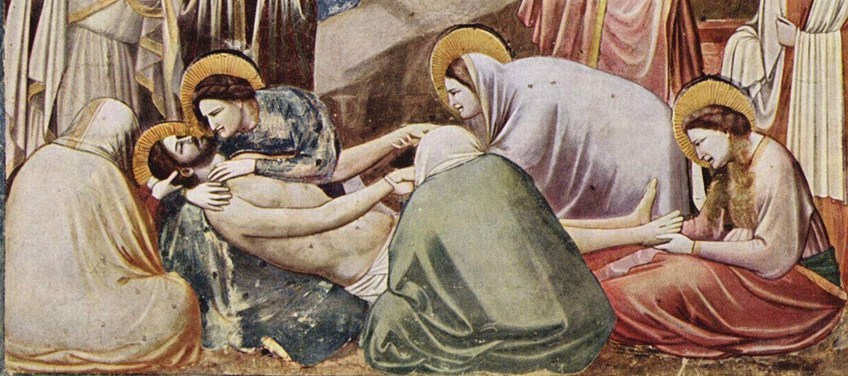
If we look at the other figures around Jesus Christ, to the right are three men; the one standing with his arms held open and bending over towards Jesus’s body is believed to be John the Apostle. The two men behind John the Apostle are believed to be Joseph of Arimathea, who stands to the left with a longer beard, and Nicodemus, standing to his left (our right).
Both men are referred to in the Gospel of John (Verse 19, 38 to 42) in the Holy Bible and are tasked with wrapping up and burying Jesus Christ’s body.
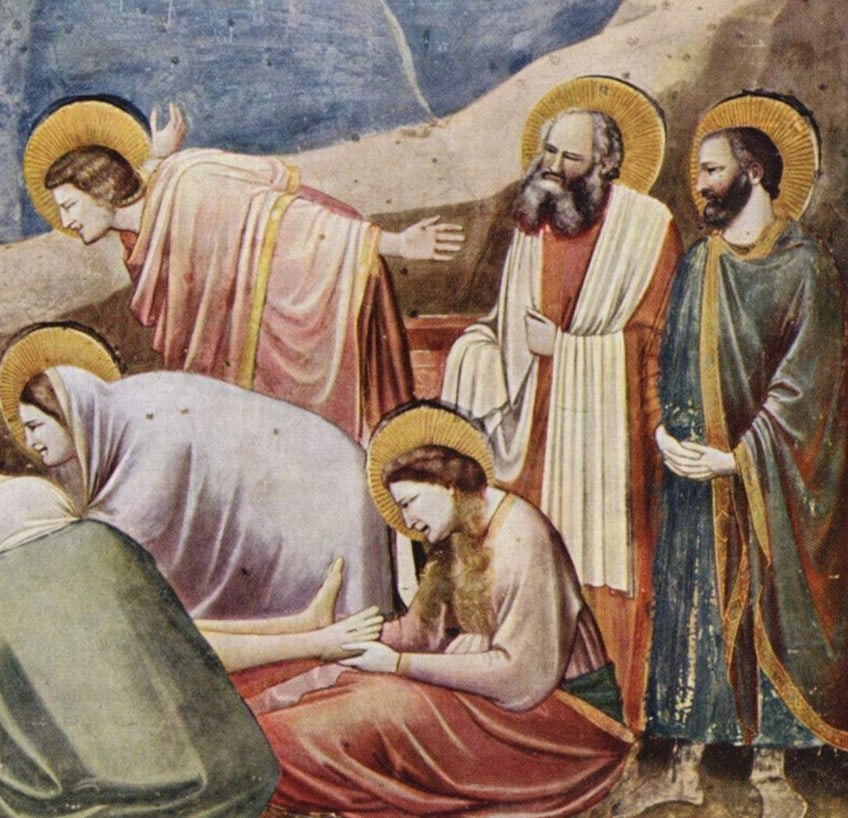
To the left of the composition is a procession of people receding into the background. The facial expressions of the two figures in the front appear grief-stricken and sorrowful; the figure on the left has her hands up and it appears as if she is crying, and the figure to her left (our right) clasps both her hands and holds them against her left cheek with her head slightly tilted in quiet sadness.

In the upper portion of the composition are ten cherub-like angels with wings, they are flying in the blue heavens above. They also appear grief-stricken, and some are crying out while others are more mournful with their heads bowed. The angels above have golden halos and we will notice only several of the figures below have halos, and not all of them.
The halos are possibly suggestive of the figures’ divine importance in the scene and the overall Biblical narrative they originate from.
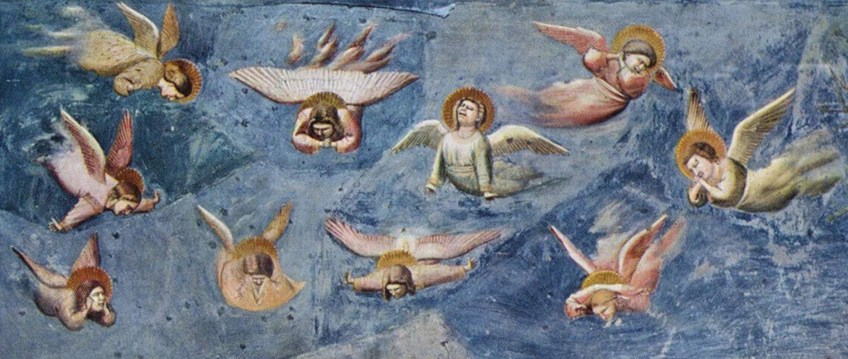
There is a sloping ridge in the middleground of the composition, and behind the figures in the foreground. Atop its tip, to the right edge of the composition, is a tree that appears bare except for a few leaves growing out at the top of its branches. Some sources suggest the tree could be the Tree of Knowledge.
The sloping ridge also hints at the divide and connection between the sky above and earth below, thus also referring to Heaven and Earth. It also leads our gaze towards the scene in the foreground.
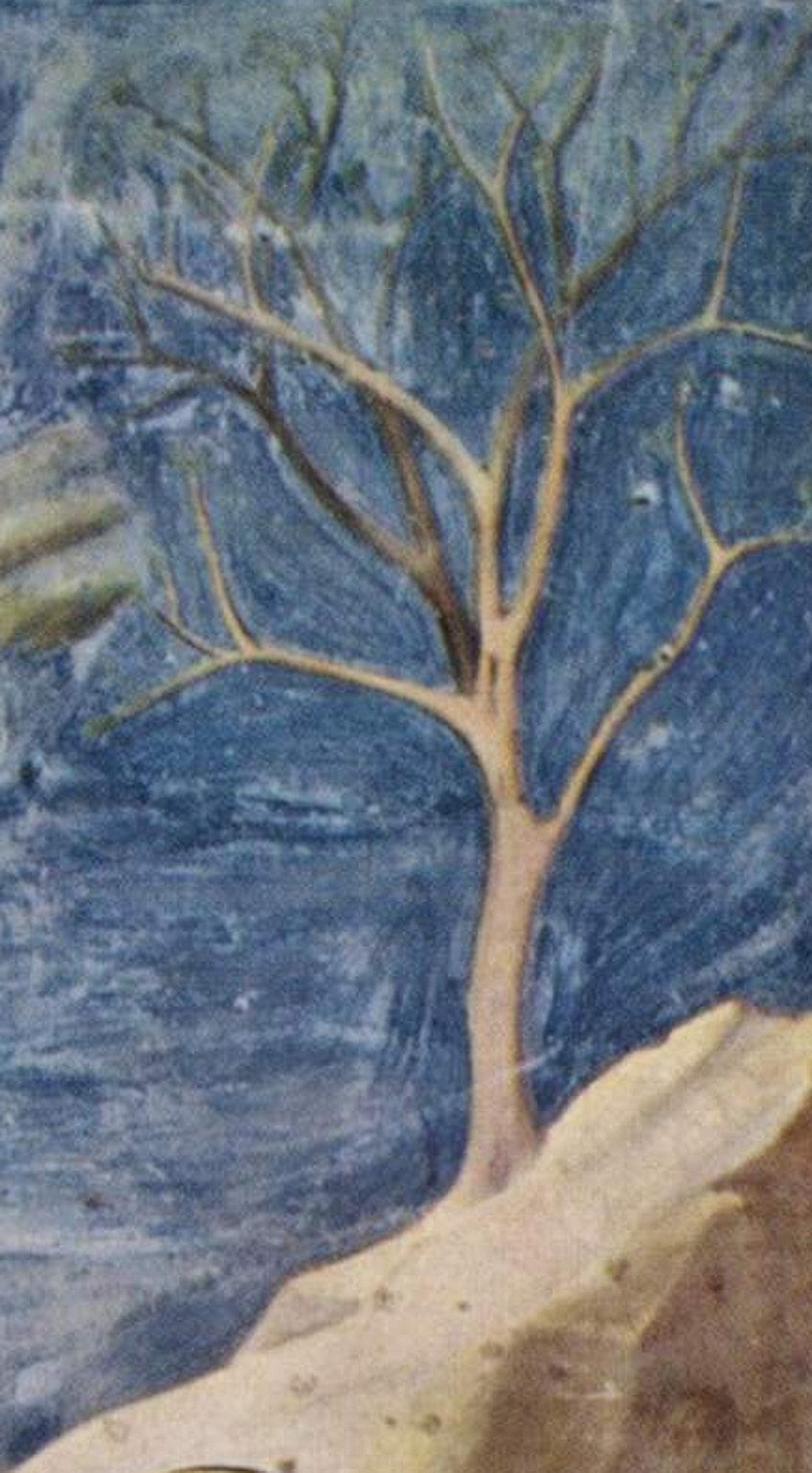
The mood of The Lamentation painting is around grief and apparent sorrow over Jesus Christ’s death. Giotto depicted the figures either in quiet sadness, as mentioned above, or more outwardly mournful, as is evident in the way their mouths are opened, giving them naturalistic humanity that we, the viewers, can certainly relate to.
Color
Looking at how Giotto utilized color in The Lamentation painting, he portrayed his subject matter in a naturalistic color scheme, incorporating soft pastel hues of blues, reds, greens, pinks, oranges, and yellows, all of which create a color harmony for the composition as a whole.
The figures in the foreground appear in lighter-colored robes compared to the figures in the background, whose robes appear darker, which could also suggest a play on light and shadow.
The angels’ robes and halos are depicted in soft pinks, whites, and golds. Furthermore, the sky is a beautiful blue set against the earthy browns from the ground, the sloping ridge, and the tree at the top of it. Additionally, the figures all have fair skin tones with natural brown and gray hair colors.

Texture
In The Lamentation of Christ by Giotto, the texture is implied in the soft drapery of the clothing and smoothed skin tones of the figures, which also creates a contrasting effect against the rougher, rocky texture from the sloping ridge and ground in the foreground of the composition.
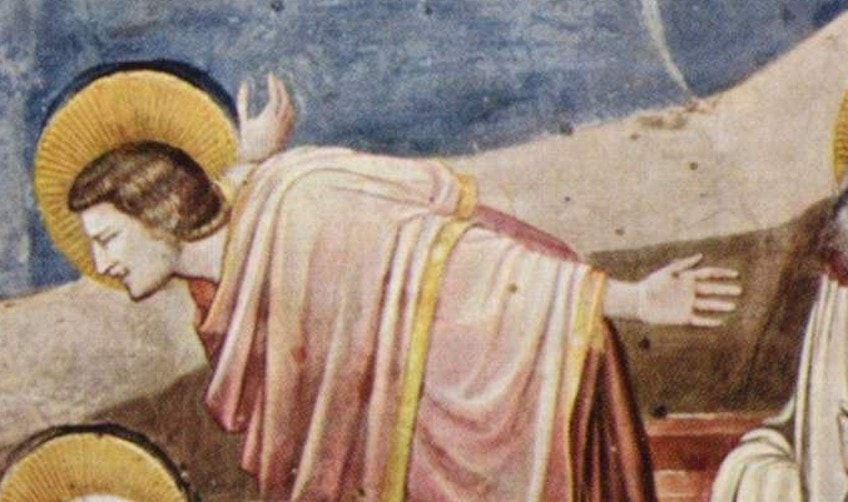
Line
There is an interplay of horizontal and vertical lines in The Lamentation of Christ by Giotto di Bondone, for example, the horizontal line created from Jesus Christ’s body, is contrasted with the vertical line formed by some of the figures who are standing up as well as the tree on the rocky ridge. We also see these vertical lines portrayed as the folds on the figures’ robes.
There is also a variety of lines created from the more diagonal line of the rocky ridge that intersects the middleground.
More diagonal and curved lines are created by the body postures of the angels in the sky as well as the hunched-over figures in the foreground, all of which heighten the naturalistic aspects of the composition, as well as create movement and dynamism, giving the figures and narrative of the composition a life-like appearance.
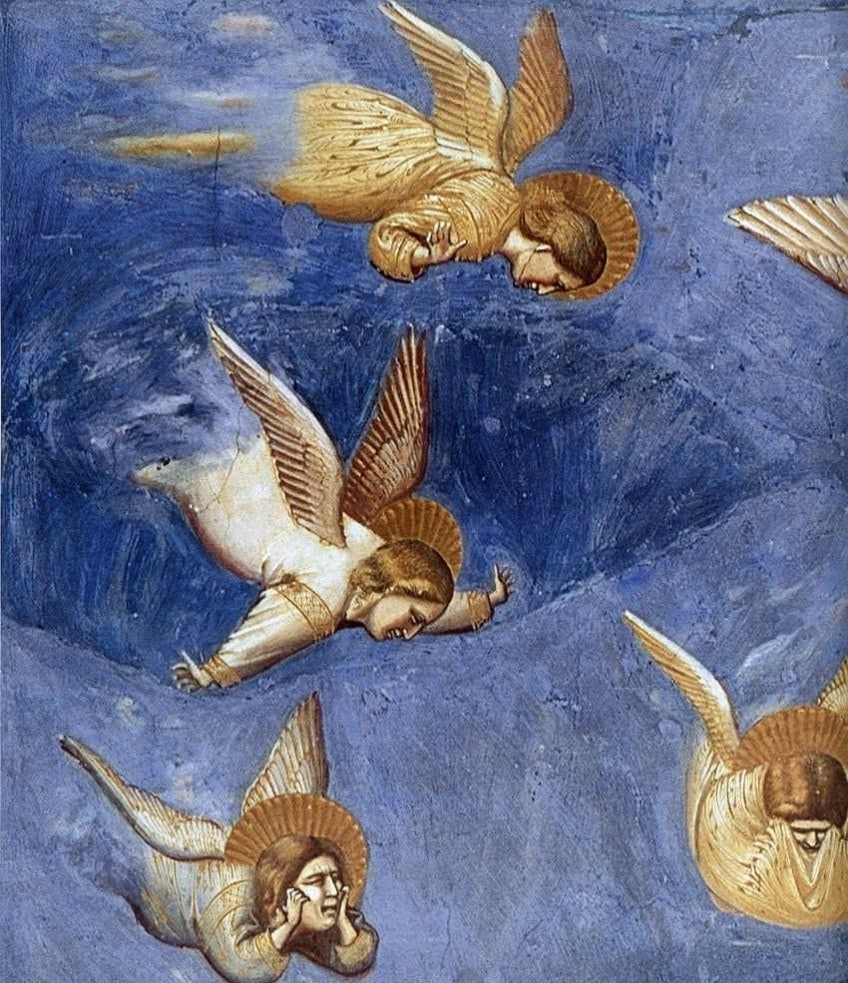
Shape and Form
There is a variety of shapes and forms in The Lamentation of Christ by Giotto di Bondone, for example, the rounded forms of the figures in the foreground who are sitting with their backs to us, the viewers. The figures are also portrayed as more voluminous in their form, which is created by their clothing.

Space
Giotto creates a three-dimensional space in The Lamentation painting, which was not a norm for paintings during the medieval period. For example, the proportion between the larger figures in the foreground compared to the smaller figures in the background provides a sense of depth. Furthermore, the voluminousness of the figures contributes to the idea of three-dimensionality; the figures are not flat and lacking in naturalism.
However, the background appears flat due to the solidity of the blue background, which acts almost like a backdrop, highlighting the figures in the foreground.

Giotto di Bondone: A Bridge Between Art Worlds
Giotto di Bondone left his legacy through his artistic style and is often praised for how he portrayed a newer level of “humanity” for his subject matter. He bridged a gap, so to say, from the flatter, stylistic Byzantine art styles to the more voluminous, three-dimensionality we see in his artworks – he breathed new life into his compositions but also showed the world what life looks like on two-dimensional surfaces.
He is often called the “Father of the Renaissance”, and influenced numerous artists, from the early painters like Masaccio to the later Leonardo da Vinci. Giotto is a prerequisite for anyone who is studying the Renaissance and while we have only briefly discussed the Giotto “Lamentation” analysis above; one of his more famous artworks, we encourage you to delve deeper.
Frequently Asked Questions
Who Painted The Lamentation Fresco?
The Florentine artist Giotto di Bondone painted The Lamentation fresco around 1304 and 1306. It is sometimes also titled The Lamentation Over the Dead Christ. However, there have been numerous artists throughout history who painted this popular Biblical story.
Where Is The Lamentation by Giotto di Bondone?
The Lamentation (c.1304 – 1306) by Giotto di Bondone is part of a series of frescoes that were painted in the Arena (Scrovegni) Chapel in Padua, Italy. It was commissioned by Enrico Scrovegni who wanted to decorate a chapel that he built on the same land as his palace.
What Is Different About The Lamentation by Giotto di Bondone?
The Lamentation (c. 1304 – 1306) by Giotto di Bondone is from the proto-Renaissance art period, which portrays more three-dimensionality and volume in its subject matter compared to how Christian art was painted, flat and two-dimensional, in the preceding Byzantine period. This change in art style made Giotto one of the pioneering forerunners of the Renaissance.
Alicia du Plessis is a multidisciplinary writer. She completed her Bachelor of Arts degree, majoring in Art History and Classical Civilization, as well as two Honors, namely, in Art History and Education and Development, at the University of KwaZulu-Natal, South Africa. For her main Honors project in Art History, she explored perceptions of the San Bushmen’s identity and the concept of the “Other”. She has also looked at the use of photography in art and how it has been used to portray people’s lives.
Alicia’s other areas of interest in Art History include the process of writing about Art History and how to analyze paintings. Some of her favorite art movements include Impressionism and German Expressionism. She is yet to complete her Masters in Art History (she would like to do this abroad in Europe) having given it some time to first develop more professional experience with the interest to one day lecture it too.
Alicia has been working for artincontext.com since 2021 as an author and art history expert. She has specialized in painting analysis and is covering most of our painting analysis.
Learn more about Alicia du Plessis and the Art in Context Team.
Cite this Article
Alicia, du Plessis, ““The Lamentation of Christ” by Giotto di Bondone – An Analysis.” Art in Context. August 19, 2022. URL: https://artincontext.org/lamentation-of-christ-by-giotto-di-bondone/
du Plessis, A. (2022, 19 August). “The Lamentation of Christ” by Giotto di Bondone – An Analysis. Art in Context. https://artincontext.org/lamentation-of-christ-by-giotto-di-bondone/
du Plessis, Alicia. ““The Lamentation of Christ” by Giotto di Bondone – An Analysis.” Art in Context, August 19, 2022. https://artincontext.org/lamentation-of-christ-by-giotto-di-bondone/.


